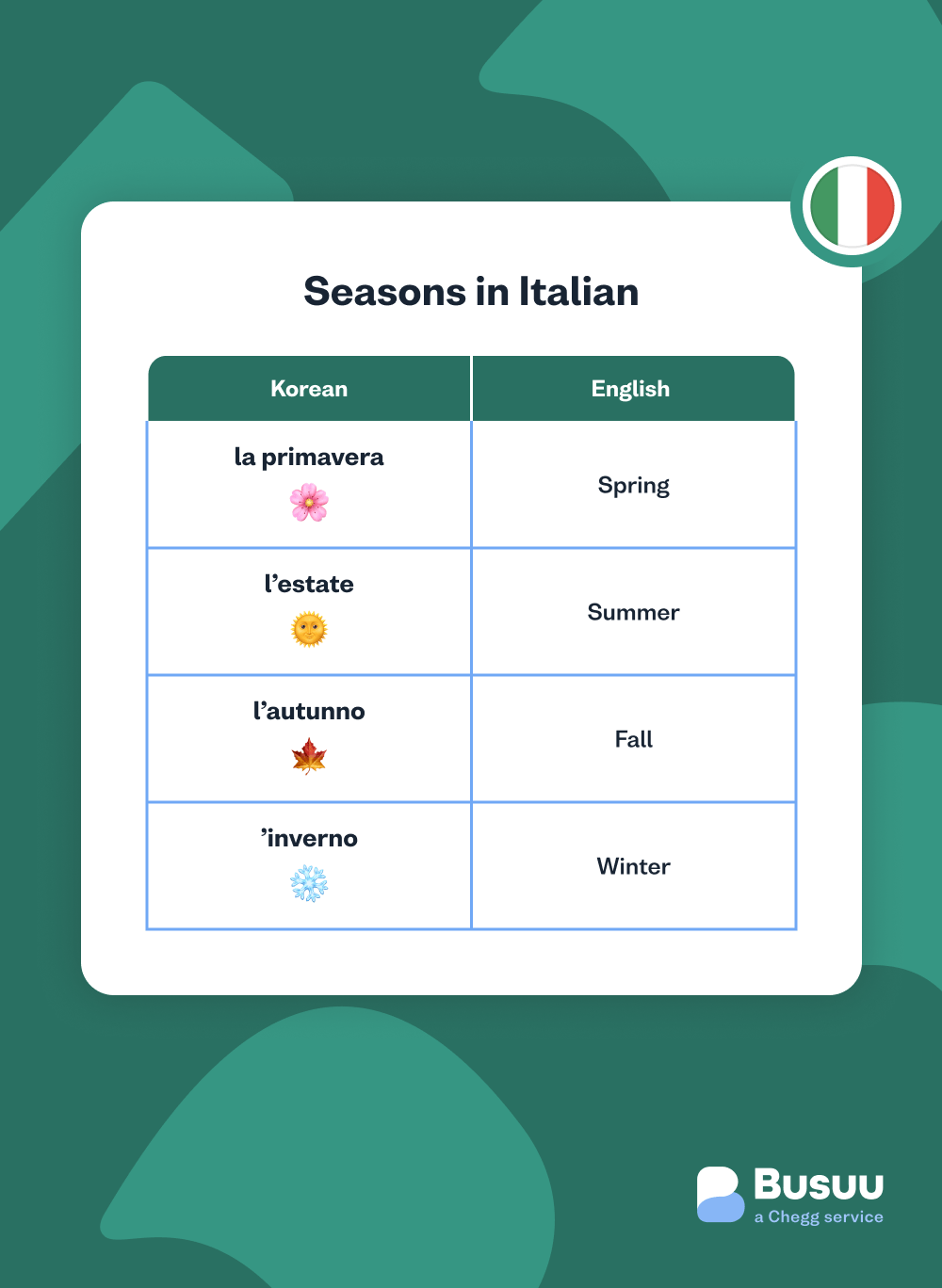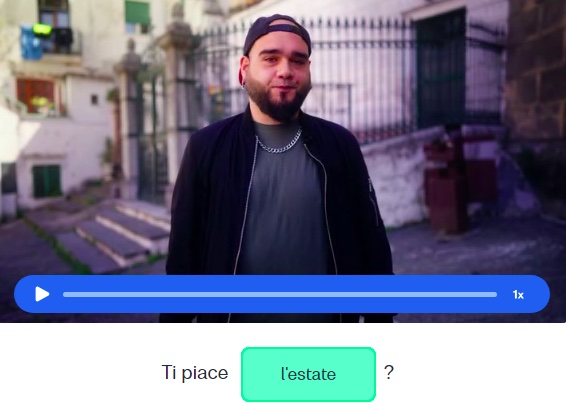A Guide to Seasons in Italian
Discover the vocabulary, traditions and weather conditions of the Italian seasons.
I want to learn...
Seasons mean a lot to Italians, so learning how to talk about seasons in Italian is an important skill. The seasons in Italy change the look and day-to-day life of most Italian cities and towns. There are four seasons in Italy, and they are such a meaningful part of the culture that Italian composer Antonio Vivaldi wrote a concerto about them (Le quattro stagioni, meaning ‘the four seasons’ in Italian) and a popular pizza is named after them.
Italy is a long peninsula which has many different landscapes in its territory (think about the mountainous regions that border Switzerland in the north, compared with the island of Sicily, which is not that far from the coasts of Africa!). This means the characteristics of each season can obviously vary quite a lot depending on the location. However, there are also points in common, and we’ll talk about them in this article.

Knowing words and characteristics related to the Italian seasons is handy from a practical point of view, like when you are traveling or planning a trip to Italy, so that you know what to expect and can plan your visit based on the sort of weather you enjoy the most.
But this is not the only reason to read about Italian seasons – by learning what Italians do in each season and how their lives change following the seasonal cycles throughout the year, you can learn a lot about their culture as well!
Seasons in Italy
Conventionally, Italian seasons have a precise beginning and end. They start on the twenty-first of December, March, June and September. Do you know what these dates are? They are the dates of the solstices (December 21 and June 21) and the equinoxes (March 21 and September 21). The solstices are the day with the fewest hours of light in the year (December 21) and the one with the most hours of light (June 21). The equinoxes are the two days of the year when day and night are the same length.
Winter in Italy
When the year starts in January, it is winter in Italy. Winter in Italian is ‘l’inverno.’
The cold season begins a few days before Christmas, on December 21, and ends on March 20. So it’s a season marked by the most important celebration of the Catholic calendar, Christmas, or ‘Natale’ in Italian. This is celebrated with big family meals, an exchange of presents, and eating lots of panettone and pandoro. Many Italians go to mass at midnight on Christmas Eve.
More holidays follow, with Santo Stefano (Boxing Day), Capodanno (New Year’s Day), and another Catholic celebration, l’Epifania (the Epiphany), on the sixth of January. Italians call this more popularly ‘la Befana,’ referring to the old lady on a broom who on that day brings sweets to good children and coal to naughty ones.
Schools are closed for this entire period, and many Italians use this time to go on vacation in the mountains, skiing or doing other winter sports. This is why the winter holiday is usually called ‘la settimana bianca’ (‘the white week’), as opposed to the long summer holidays, which are usually at the seaside.
Winter is also Carnival season. This is another Catholic holiday that does not always fall on the same day, but it’s usually in February or at the beginning of March. Traditionally, the Carnival is the last occasion to eat, drink and party before the restrictions of Lent.
During Carnival, there are parades in the streets of most cities and towns in Italy. Children (and not only children) dress up and throw coriandoli (confetti) and stelle filanti (streamers) in the air. In some cities the celebrations are particularly spectacular – the most famous Carnival celebrations are in Venice and Viareggio.
Winter is relatively cold in northern Italy, where temperatures in January and February are usually between 32° and 50°F. It is obviously colder in the mountains, with sub-zero temperatures being the norm throughout the winter. The season is warmer in southern Italy and on the coasts, where it’s not uncommon to have temperatures between 50° and 59°F and sometimes higher.
Fun fact: The last 3 days of January are believed to be the coldest of the year and are called ‘i giorni della merla’ (‘the blackbird days’) in Italian. The popular story behind this expression is that a female blackbird, which used to have white feathers, sought refuge in a chimney because of the extreme cold, and that’s how the color of its feathers changed to gray.
Winter in Italy is a relatively quiet time for tourism in cities and on the seaside. Most seaside towns that are bursting with people for the entire summer are completely different places in the cold season, empty and quiet. The Italian ‘città d’arte’ (art cities) are also less busy in winter than in summer. However, winter is the prime season, obviously, for skiing holidays!
Winter words in Italian
| Italian word | English translation |
|---|---|
| l’inverno | winter |
| dicembre | December |
| gennaio | January |
| febbraio | February |
| freddo | cold |
| la neve | snow |
| il ghiaccio | ice |
| la nebbia | fog |
| la sciarpa | scarf |
| il cappello | hat |
| i guanti | gloves |
| la coperta | blanket |
| il camino | chimney, fireplace |
| il fumo | smoke |
| Natale | Christmas |
| Capodanno | New Year’s Day |
| Carnevale | Carnival |
| costume | costume |
| maschera | mask |
| coriandoli | confetti |
| stelle filanti | streamers |
| la settimana bianca | white week (winter holiday) |
| in montagna | in the mountains |
| sciare | to ski |
| gli sci | skis |
| lo snowboard | snowboard |
Spring in Italy
Spring is ‘la primavera’ in Italian. It begins on March 21 and lasts until June 20. This is a wonderful season in Italy, when flowers bloom, days become longer and temperatures become warmer – but not as hot as in the summer. Italians don’t usually like the ‘bad weather,’ and spring is when they start enjoying life outdoors again.
The temperatures in spring rise from around 50°F in March to around 68°F in May, with the usual differences between the north and south, and with lower temperatures in the mountains. So April and May are excellent months to visit Italian cities or for a trip in nature.
Temperatures in the sixties are perfect for sightseeing, hiking or cycling, and there are enough hours of daylight to allow you to fully explore cities or natural landscapes and enjoy your days from early morning until the evening.
In southern Italy and on the islands, where temperatures rise to the upper seventies, you might even be able to go to the beach and swim in the sea!
In spring Italians celebrate another Catholic holiday, Easter. This doesn’t have a fixed date, but happens every year towards the end of March or in April. It is the most important holiday for Catholics, who in the days before Easter observe a complex schedule of masses, including a three-hour mass on the night before Easter. In Italian this is called ‘la Veglia pasquale’ (‘the Easter vigil’).
Apart from religious celebrations, Italians normally have a big meal with the family on Easter, traditionally including lamb, and children break open their chocolate eggs.
However, there’s an Italian saying that goes, “Natale con i tuoi, Pasqua con chi vuoi” (“Christmas with your family, Easter with whomever you want”). This refers to the fact that while it’s mandatory to spend Christmas with the family, it’s acceptable to spend Easter with someone else (although your grandma will always be very disappointed if you do!).
The day after Easter is another holiday, officially called ‘il lunedì dell’Angelo’ (‘the Angel Monday’), and unofficially ‘Pasquetta’ (‘little Easter’). The most popular Italian tradition on this day is to gather for a big grigliata (barbecue) with friends in someone’s garden, in a city park, or even better, out of town.
On April 25, Italians celebrate ‘la Festa della Liberazione’ (Liberation Day). On this day in 1945, the north of Italy, which was still occupied by Nazis and fascists, was liberated by the Allied powers and Italian fighters. It is a very important national occasion for Italians and is celebrated sincerely by many people. Several events are organized in towns and cities, including large parades in city centers and important public spaces. These are often followed by speeches, public talks and concerts.
Spring words in Italian
| Italian word | English translation |
|---|---|
| la primavera | spring |
| marzo | March |
| aprile | April |
| maggio | May |
| i fiori | flowers |
| fiorire | to bloom, to blossom |
| le foglie | leaves |
| gli uccelli | birds |
| la rondine | swallow (bird) |
| Pasqua | Easter |
| l’uovo, le uova | egg, eggs |
| cioccolato | chocolate |
| Pasquetta | Easter Monday |
| grigliata | barbecue |
| passeggiata | walk |
| bicicletta, bici | bike |
| Festa della Liberazione | Liberation Day |
Summer in Italy
Summer, or ‘l’estate’ in Italian, is the hot season in Italy. It begins on June 21, the longest day of the year, and ends on September 21. It’s often the favorite season of Italian children and teenagers, and it’s not difficult to understand why – schools are closed from June until September for the long summer holidays.
In summer, the weather can get quite hot, with the usual variations depending on location. Temperatures are usually between 77° and 95°F, with July and August being the hottest months. It is not uncommon, especially in recent years, for the temperature to reach 104°F, particularly in the south and on the islands.
Summer is cooler in the mountains, and depending on the altitude, temperatures are around 50° to 77°F. Summer is the high season for tourism at the seaside, lakes, and in cities – even though some of these can become quite unwelcoming places in the heat. Virtually every town on the sea will fill with beach goers for the whole season – if you dream of a seaside holiday in Italy in summer, you’d better book a few months in advance.
Italians love their summer vacations, and most people will take a few weeks off work in August or in July. A large portion of them like to spend their holidays at the seaside, which explains the crowds. However, the mountains are also a popular destination for those who prefer hiking, climbing and the cooler weather.
Many companies and businesses shut down for two or three weeks in August. It’s good to know that in cities and towns that don’t see a lot of tourism, most shops and establishments will probably be closed around this time. But don’t worry – businesses in touristy places keep their doors open in the high season.
On August 10, ‘la notte di San Lorenzo’ (‘the night of St. Lawrence’), many Italians spend the night ‘con il naso all’insù’ (‘with their nose looking upwards’), looking at the starry sky. According to a popular tradition, this night has the highest number of shooting stars in the whole year, and spotting them brings good luck.
A few days later, the holiday of Ferragosto marks the height of summer, on August 15. Most Italians are on holiday at this time anyway. But for those who aren’t, the tradition is to spend the day out of town, ideally near some water to swim in – be it the sea, a river or a lake – to escape the heat.
Summer words in Italian
| Italian word | English translation |
|---|---|
| l’estate | summer |
| giugno | June |
| luglio | July |
| agosto | August |
| caldo | hot |
| sole | sun, sunshine |
| vacanze | vacation, holidays |
| mare | sea, seaside |
| spiaggia | beach |
| onde | waves |
| costume da bagno | swimsuit |
| occhiali da sole | sunglasses |
| crema solare | sunscreen |
| prendere il sole | to sunbathe |
| fare un tuffo, tuffarsi | to dive |
| maschera da sub | diver’s mask |
| immersione, sub | scuba diving |
| barca | boat |
| gelato | ice cream |
| lago | lake |
| fiume | river |
Autumn in Italy
Autumn is ‘l’autunno’ in Italian – remember to pronounce all the vowels! (Need a refresher on pronunciation? Check out our guide to the Italian alphabet.)
Autumn begins on September 21 and ends on December 21. After the long summer holidays, autumn feels like a new start for many Italians. Businesses and companies reopen, people go back to work, kids go back to school, and everything returns to normal.
The weather is often still quite warm in September, especially during the first half of the month and in the south and on the islands. Similar to the end of spring, September is a great month for a beach holiday or a city getaway. Beaches and cities are much less busy than in the summer, as the long Italian holidays are over, and with them the high tourist season.
Temperatures are milder than in the summer but still suitable for going to the beach, and they are perfect for wandering about a city. This is also a great month for hiking or cycling holidays. Temperatures range from 60° to 77°F in September and gradually decrease to between 32° and 50°F in December, with October and November being relatively rainy months.
In the mountains, the weather has usually turned colder and more ‘autumnal’ by the end of August, and by November it’s common to start having snow, especially over 5000 feet. The ‘stagione sciistica’ (ski season) starts again around the end of November or beginning of December when ski resorts reopen for the winter.
Autumn is a very sentimental season. It is commonly associated with feelings of melancholy and sadness, as days become shorter and leaves fall off trees, with nature preparing for the winter. However, the bright and beautiful colors of fall can also elicit positive feelings of warmth and cheerfulness.
In Italy, many autumn activities are linked to the woods and mountains. The leaves of some types of trees turn yellow, orange and red for a few weeks, creating spectacular landscapes in parts of the mountains. In Italian we use the English term ‘foliage’ for this phenomenon, which happens in October and November. For this reason, these are considered excellent months for hiking in the mountains, as being surrounded by the fall colors can be breathtaking.
Autumn is also the season for picking mushrooms and chestnuts, another fall activity that Italians love and that happens in woods and mountains. The best months for picking mushrooms are September and October, stretching into November, until the snow comes. The same goes for chestnuts, which fall off chestnut trees in the same period. Italians flock to the woods in autumn, and in the most popular spots the mushrooms and chestnuts disappear in a matter of days!
Autumn is also the season for another very significant event in the Italian calendar – ‘la vendemmia,’ the grape harvest. This picturesque event tied to the countryside and the agricultural landscape happens from around the end of August until November, depending on the grape varieties.
Until not that long ago, la vendemmia was a central event in the lives of peasants and farmers, a real ‘collective ceremony’ where entire communities were engaged for days in harvesting, pressing the grapes with their feet and producing the wine.
Nowadays, wine is mostly produced with modern machinery, but la vendemmia is still a charming event that grounds Italy in its past and its traditions, and it is instrumental to the making of one of Italy’s most celebrated products, wine.
Autumn words in Italian
| Italian word | English translation |
|---|---|
| l’autunno | autumn, fall |
| settembre | September |
| ottobre | October |
| novembre | November |
| la pioggia | rain |
| l’impermeabile | raincoat |
| stivali da pioggia | rain boots |
| l’ombrello | umbrella |
| funghi | mushroom |
| castagne | chestnuts |
| raccogliere | to pick, to harvest |
| foglie | leaves |
| rosso | red |
| arancione | orange |
| giallo | yellow |
| il vino | wine |
| la vendemmia | wine harvest |
Wrapping up
Italian seasons are not just annual changes, but are deeply cultural. The season and the weather greatly influence the habits, happenings and lifestyle of Italians, so it’s interesting to look at them not only from the point of view of vocabulary, but also through culture, as we’ve done in this article.
Italian cities, towns and natural sites will be very different places according to which season of the year you choose to visit them. Now that you understand what you can expect from each season in Italy and some words to describe them, why not practice your Italian to prepare for your next vacation? A little language will go a long way on a visit to Italy.
Are you ready for more Italian?
Immerse yourself in the beauty of the Italian language, exploring tons of grammar, vocabulary and culture using Busuu’s free online courses. Connect with our vibrant community of native speakers and begin your learning adventure!

